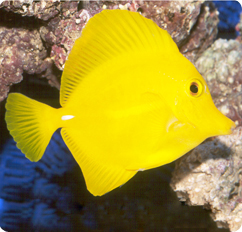|
Zebrasoma flavescens - Yellow Tang
The Perfect Marine Aquarium Fish  The yellow tang (Zebrasoma flavescens) is no stranger to the marine aquarist. This brightly colored, active and gregarious fish is a saltwater aquarium favorite and for good reason. Hardy, with a fairly good temperament and an attention-grabbing flash of yellow, the yellow tang, like many of the Zebrasoma species, is a fantastic fish for many a reef or fish-only aquarium. Not convinced? Well consider that the yellow tang is amongst the most disease-resistant tangs available and, to top it off, it loves filamentous algae. While there are a few things you should know (and we’ll cover these things in this article), we are here to tell you that the yellow tang is one great marine aquarium fish. The yellow tang (Zebrasoma flavescens) is no stranger to the marine aquarist. This brightly colored, active and gregarious fish is a saltwater aquarium favorite and for good reason. Hardy, with a fairly good temperament and an attention-grabbing flash of yellow, the yellow tang, like many of the Zebrasoma species, is a fantastic fish for many a reef or fish-only aquarium. Not convinced? Well consider that the yellow tang is amongst the most disease-resistant tangs available and, to top it off, it loves filamentous algae. While there are a few things you should know (and we’ll cover these things in this article), we are here to tell you that the yellow tang is one great marine aquarium fish.
Yellow Tangs in the Wild
Sometimes called the yellow sailfin tang, the lemon sailfin, the somber surgeonfish, or the Lau ipala, the yellow tang hails from the Pacific Ocean from Ryukyu, Mariana, Marshall, Marcus, and Wake Islands all the way to the Hawaiian Islands. Most yellow tangs collected for the marine aquarium hobby come from Hawaii. Growing to about 20 centimeters, the yellow tang prefers coral reefs in both protected lagoons and seaward reefs. In the wild, yellow tangs may be seen singly or in groups constantly picking at the reef in their perpetual pursuit of filamentous algae.
A Yellow Tang Ready Aquarium
In the aquarium, the yellow tang also spends its days picking at the rockwork, and, as a result, it is nearly unthinkable to keep this species in any aquarium without plenty of live rock. An adult yellow tang requires an aquarium of at least 75 gallons and, as an adult, should be kept as the only member of its species in any aquarium smaller than 150 gallons. The yellow tang-ready aquarium will have loads of swimming space in addition to copious amounts of live rock, and water movement will be brisk in order to assist with oxygen exchange at the surface.
While yellow tangs are rightfully considered hardy, they will do best with high, stable water quality. Do not subject your yellow tang to poor water quality or, worse, wildly fluctuating parameters (especially when it comes to pH, salinity and temperature). While the yellow tang is one of the most disease and infestation resistant tangs, all tangs are susceptible to common ailments when stressed.
In addition, Mark Martin, director of marine ornamental research at Blue Zoo Aquatics, recommends using Kent Marine’s Essential Elements in conjunction with any synthetic salt mix in any tank housing a tang. “It seems to add in what is lacking in the salt mix,” says Martin, who points out that, in his experience, natural sea water is the only "cure" for one of the more common tang ailments—so-called lateral line erosion [For more information, see our article on common tang ailments, prevention and treatment. –Ed].
Introducing a Tang to Your Aquarium
When introducing a tang to a mature, established reef tank or fish-only system, consider adding the tang last (or close to last) in your stocking order, and always quarantine the fish for at least 10 days to two weeks. Also, try to avoid using a net when moving a tang, as its peduncular spine is easily tangled and this can result in injury and subsequent infection. Instead of a net, use a collection cup whenever possible.
Feeding a Yellow Tang a Varied and Nutritious Diet
Feeding a yellow tang a varied and nutritious diet is perhaps the most important thing the aquarist can do when it comes to avoiding problems. Tangs should be offered high quality foods formulated for herbivores along with frequent feedings of dried marine algae like nori (from the Asian food aisle at most markets) or a commercially prepared sheet food like Sea Veggies. Spirulina flakes and frozen mysis shrimp are also appreciated.
Most yellow tangs will readily take any other flake, frozen or pellet food you are feeding to your other fishes. Martin suggests soaking flake food in a vitamin supplement like Selcon or a garlic supplement in order to help the fish fight off any possible parasite infestation and offer balanced nutrition. While many people will talk about tangs’ susceptibility to protozoan parasites and other ailments, we have found a tang that has been fed a nutritious diet is almost always a healthy tang for many years in the home aquarium.
A Fantastic Marine Aquarium Fish
Beautiful, hardy and a fiend for filamentous algae, the yellow tang is a fantastic fish for most marine aquaria.
|